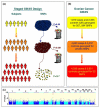The inherited genetics of ovarian and endometrial cancer
- PMID: 20456938
- PMCID: PMC3073171
- DOI: 10.1016/j.gde.2010.03.001
The inherited genetics of ovarian and endometrial cancer
Abstract
Endometrial and epithelial ovarian cancers are the fourth and fifth most common cancers in women in developed countries, after breast, lung, and colorectal cancer. In the United States alone, in 2008 there were about 40,000 new diagnoses of endometrial cancer and 7500 disease-related deaths. For ovarian cancer, there were about 22,000 new diagnoses and 15,000 deaths over the same period. The purpose of this article is to review the recent developments in the inherited genetics of ovarian and endometrial cancer, with particular attention to recent progress in identifying common low-penetrance susceptibility genes and their clinical implications.
Figures


Similar articles
-
Impact of MDM2 promoter SNP55 (rs2870820) on risk of endometrial and ovarian cancer.Biomarkers. 2021 Jun;26(4):302-308. doi: 10.1080/1354750X.2021.1891291. Epub 2021 Feb 28. Biomarkers. 2021. PMID: 33645339
-
Role of common genetic variants in ovarian cancer susceptibility and outcome: progress to date from the Ovarian Cancer Association Consortium (OCAC).J Intern Med. 2012 Apr;271(4):366-78. doi: 10.1111/j.1365-2796.2011.02509.x. J Intern Med. 2012. PMID: 22443200 Review.
-
Gynecologic manifestations of hereditary nonpolyposis colorectal cancer. From inherited to sporadic disease.Oncology (Williston Park). 2006 Jan;20(1):85-94; discussion 94-6, 100. Oncology (Williston Park). 2006. PMID: 16572595 Review.
-
Genetic Contribution of Endometriosis to the Risk of Developing Hormone-Related Cancers.Int J Mol Sci. 2021 Jun 4;22(11):6083. doi: 10.3390/ijms22116083. Int J Mol Sci. 2021. PMID: 34199930 Free PMC article.
-
Cross-Cancer Genome-Wide Association Study of Endometrial Cancer and Epithelial Ovarian Cancer Identifies Genetic Risk Regions Associated with Risk of Both Cancers.Cancer Epidemiol Biomarkers Prev. 2021 Jan;30(1):217-228. doi: 10.1158/1055-9965.EPI-20-0739. Epub 2020 Nov 3. Cancer Epidemiol Biomarkers Prev. 2021. PMID: 33144283
Cited by
-
Epidemiology and risk factors for ovarian cancer.Prz Menopauzalny. 2023 Jun;22(2):93-104. doi: 10.5114/pm.2023.128661. Epub 2023 Jun 14. Prz Menopauzalny. 2023. PMID: 37674925 Free PMC article. Review.
-
Variants in the Signaling Protein TSAd are Associated with Susceptibility to Ovarian Cancer in BRCA1/2 Negative High Risk Families.Biomark Insights. 2012;7:151-7. doi: 10.4137/BMI.S10815. Epub 2012 Dec 12. Biomark Insights. 2012. PMID: 23300341 Free PMC article.
-
The double-edged sword of ovarian cancer information for women at increased risk who have previously taken part in screening.Ecancermedicalscience. 2016 Jun 30;10:650. doi: 10.3332/ecancer.2016.650. eCollection 2016. Ecancermedicalscience. 2016. PMID: 27433283 Free PMC article.
-
Histone deacetylases as new therapy targets for platinum-resistant epithelial ovarian cancer.J Cancer Res Clin Oncol. 2016 Aug;142(8):1659-71. doi: 10.1007/s00432-015-2064-5. Epub 2015 Nov 11. J Cancer Res Clin Oncol. 2016. PMID: 26560874 Free PMC article. Review.
-
Expression of Cyclin D1 in Hyperplasia and Carcinoma of Endometrium and Its Correlation with Histologic Grade, Tumor Type, and Clinicopathological Features.J Lab Physicians. 2020 Dec;12(3):165-170. doi: 10.1055/s-0040-1721150. Epub 2020 Nov 23. J Lab Physicians. 2020. PMID: 33268933 Free PMC article.
References
-
- Stratton JF, Pharoah PDP, Smith SK, Easton DF, Ponder BAJ. A systematic review and meta-analysis of family history and risk of ovarian cancer. Br J Obstet Gynaecol. 1998;105:493–499. - PubMed
-
- Gruber SB, Thompson WD. A population-based study of endometrial cancer and familial risk in younger women. Cancer and Steroid Hormone Study Group. Cancer Epidemiol Biomarkers Prev. 1996;5(6):411–417. - PubMed
-
- Lucenteforte E, Talamini R, Montella M, Dal Maso L, Pelucchi C, Franceschi S, La Vecchia C, Negri E. Family history of cancer and the risk of endometrial cancer. Eur J Cancer Prev. 2009;18(2):95–99. - PubMed
-
- Parazzini F, Negri E, La Vecchia C, Restelli C, Franceschi S. Family history of reproductive cancers and ovarian cancer risk: an Italian case-control study. Am J Epidemiol. 1992;135(1):35–40. - PubMed
-
- Lichtenstein P, Holm NV, Verkasalo PK, Iliadou A, Kaprio J, Koskenvuo M, Pukkala E, Skytthe A, Hemminki K. Environmental and heritable factors in the causation of cancer – analyses of cohorts of twins from Sweden, Denmark and Finland. N Engl J Med. 2000;343(2):78–85. - PubMed
Publication types
MeSH terms
Grants and funding
LinkOut - more resources
Full Text Sources
Other Literature Sources
Medical

